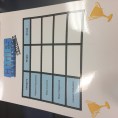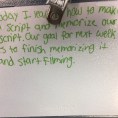Cultivating Accountability and Motivation in the Makerspace

In the Innovation Lab, our fifth and sixth grade blended learning makerspace, we see students once a week for the entire school year. During the school year we “grade” students based on their use of our design thinking process rather than grading students solely on their final products. Because we’ve blended the Innovation Lab and focus more on the process than the product, students can take as long as they like to finish a project; they can work on something, fail forward, until they are happy with the results. While we think its the best way to run the Innovation Lab, at least until we move away from the weekly format, these factors can make holding students accountable and motivating them to complete a project difficult. With lessons learned from last year, we’ve developed a few tricks to get the most out of our students. Here is how we hold students accountable and motivate them in the Innovation Lab.

Lanyards. Our Innovators physically wear lanyards during Innovation Lab. The lanyards have proven to be the best method for holding kids accountable that we’ve ever come up with. Part 1: when students enter the Lab, they grab their lanyard and an index card. On the front of the index card, students write their challenge statement. The challenge statement, part of the (re)define stage of our design thinking process, is a one sentence declaration of what students are designing, for who, and why. For example, “I’m designing a grocery reminder app for my mom because she always forgets something at the store,”would be an example of a good challenge statement. Once they’ve written their challenge statement on the index card at the beginning of class, they put their lanyard on and get to work.
This is great for students because they have a constant reminder hanging around their neck of what they should be designing. If they decide to change their project, which they have the freedom to do, they must let us know and rewrite a new challenge statement. Writing the challenge statement on the lanyard is great for us because we can review them before students come in. We like to spend a few minutes talking to each student about their project each class and thanks to the lanyards we don’t have to waste time asking students what they are working on, we already know. Instead, we can start the conversation by discussing what phase of our design thinking process they’re on. This saves a precious few seconds per student that adds up by the end of the day.
Part 2: during the last five minutes of class, students take the index card out of their lanyard. On the back, students are expected to write their goal for next week and one thing they learned during Innovation Lab. When students come in the next week, we have them start by reading the goal they wrote last week and (re)defining their challenge statement again. This cycle continues each week. The lanyards help everyone stay focused, organized, and encourages students to work through our design thinking process. This lanyard system is the back bone of accountability in the Innovation Lab.







Digital Portfolios and Digital Evidence. Our students are expected to write an entry in their digital portfolios every three weeks. In each entry, students give a big picture overview, complete with digital evidence, on what they have been doing and learning in the Innovation Lab. The digital evidence piece is important because it requires kids to take pictures and videos of their design thinking process, which makes them more mindful of how they spend their time in class. For example, while a student might want to play Survival rather than design in Minecraft, if they know that screenshots that capture the process of their build are expected in their portfolio soon, they are less likely to lose focus. Digital evidence helps students stay present and focused as they work through a design. The portfolio entries are then used as a jumping-off point for a more focused, interview-style conversation the following week. During the interview, students are asked to make direct connections to the design thinking process as they walk us through their portfolios. All of this adds a layer of urgency to what they are doing.
Time, Date, and Preparedness Limitations. We have a recording studio in the Innovation Lab. As you can imagine, it is a popular destination for many students. To keep things orderly, and to help students move forward in a design, we use limitations on when, where, and how students can use the recording studio. Whether making a podcast or a video, students can’t enter the recording studio without having a script or storyboard. Once they talk us through what they are recording, they have up to twenty minutes in the studio, then the next group goes in. Additionally, whatever they are recording can’t be longer than five minutes. If they have previous recordings that haven’t been edited into a final product, they can’t use the studio. Finally, students can signup for the studio a week in advance. By limiting how long a product can be, how long they can use the studio for, and asking them to have a plan before they can use the Studio, we have been able to get a much better workflow and more finished products than we had last year. By requiring students to have any previous recordings finished before making a new one, and allowing students to sign up a week in advance for the studio, we have added an additional layer of incentives for students to be prepared to make. We use these tactics in places other than the recording studio.
Competition. We were lucky to have Hot Wheels send us a Speedometry Kit and bunch of great video game companies like Paradox Interactive and Mohawk Games gift us some great learning AAA games. Ms. Smith and I make posters to hang on the wall that track some of the design challenges students can tackle in the Lab. Challenges like highest population, happiest population, lowest pollution, longest jump, most loops made, allow competition between classes which have many of our kids running to class to see if they still hold the record. I love gamification, so I try to use these types of game mechanics where I can to motivate students to keep them moving forward.
Tools and ideas to transform education. Sign up below.
Entrepreneurship and Narratives. More motivating than competition, narratives are great to insert into the Makerspace. Our narrative invokes pride in ownership and all the lessons and learning that comes with running a business because we’ve brought entrepreneurship to the Innovation Lab. In the Innovation Lab, students can sell their creations on FH Gizmos, our student-run school store. I made the store not only to expose students to entrepreneurship, but to also motivate them to finish more designs. When we talk about FH Gizmos with students, we talk about it as if we are part of a startup. Students who open a store on FH Gizmos are given a stock certificate which entitles them to vote at the share holders meeting; the meeting where we decide how we get to spend the profit we’ve made. Students also earn “commission” on what they sell. They can use the commission to buy things from FH Gizmos. By trying to make the experience of running their FH Gizmos store as authentic as possible, we’ve wrapped the experience in a narrative where students feel like they are part of a real business. Anytime you can add a story, or even better, an authentic narrative to the works students are doing, they’ll be more motivated to participate.
Pushing to a Larger Audience. Pushing student work to a larger audience was something I started doing as an English teacher. My students hated writing essays, but when we started blogging instead, they loved it. Part of the appeal was being able to count likes and views. Students will never work harder than if they know the whole world might see their creations. This is why social media is great in the classroom. I love social media as a tool to build relationships with students. We use social media in the Lab to capture the great things students are making. Students are generally excited to see their efforts pop-up on the Instagram feed. We also push student work to a larger audience through our digital galleries. We show off student work on the Innovation Stations, where anyone can see and hear the great things our kids have made. Students love to know how many views they have, and often start to design, create, and speak to their audience. When I told one of our podcast teams that their podcast had 500+ views, they actually started to talk to their listeners during the podcast and thank them. They even started to call their listeners Squiggly Monsters, taking a page from many celebrities who nickname their fan base. A larger audience through social media and digital galleries have been great for increasing motivation.
Hopefully you found something here you can start using in your class tomorrow!
Until Next Time,
GLHF
cross-posted at Teched Up Teacher
Chris Aviles presents on education topics including gamification, technology integration, BYOD, blended learning, and the flipped classroom. Read more at Teched Up Teacher.
Chris Aviles is a STEM teacher, edtech specialist, and president of Garden State Esports. He is also a regular contributor to Tech & Learning.
